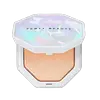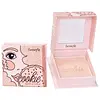What's inside
What's inside
 Key Ingredients
Key Ingredients

 Benefits
Benefits

No benefits
 Concerns
Concerns

 Ingredients Side-by-side
Ingredients Side-by-side

Synthetic Fluorphlogopite
Dimethicone
EmollientDimethicone/Vinyl Dimethicone Crosspolymer
Skin ConditioningMica
Cosmetic ColorantOctyldodecyl Stearoyl Stearate
EmollientTapioca Starch
Octyldodecanol
EmollientBoron Nitride
AbsorbentDiisostearyl Malate
EmollientSilica
AbrasiveCaprylyl Glycol
Emollient1,2-Hexanediol
Skin ConditioningCaprylic/Capric Triglyceride
MaskingTriethoxycaprylylsilane
Dehydroacetic Acid
PreservativePolymethylsilsesquioxane
Lavandula Stoechas Extract
MaskingTin Oxide
AbrasiveIron Oxides
CI 77891
Cosmetic ColorantSynthetic Fluorphlogopite, Dimethicone, Dimethicone/Vinyl Dimethicone Crosspolymer, Mica, Octyldodecyl Stearoyl Stearate, Tapioca Starch, Octyldodecanol, Boron Nitride, Diisostearyl Malate, Silica, Caprylyl Glycol, 1,2-Hexanediol, Caprylic/Capric Triglyceride, Triethoxycaprylylsilane, Dehydroacetic Acid, Polymethylsilsesquioxane, Lavandula Stoechas Extract, Tin Oxide, Iron Oxides, CI 77891
Dimethicone
EmollientMica
Cosmetic ColorantAlumina
AbrasiveIsododecane
EmollientPolyglyceryl-2 Triisostearate
EmulsifyingTriethylhexanoin
MaskingPolyethylene
AbrasiveMagnesium Myristate
Phenoxyethanol
PreservativeCaprylyl Glycol
EmollientPEG-12 Dimethicone
Skin ConditioningTin Oxide
AbrasiveCI 15850
Cosmetic ColorantCI 15985
Cosmetic ColorantCI 19140
Cosmetic ColorantCI 42090
Cosmetic ColorantCI 45410
Cosmetic ColorantCI 73360
Cosmetic ColorantCI 77007
Cosmetic ColorantCI 77163
Cosmetic ColorantCI 77288
Cosmetic ColorantCI 77289
Cosmetic ColorantCI 77491
Cosmetic ColorantCI 77492
Cosmetic ColorantCI 77499
Cosmetic ColorantCI 77510
Cosmetic ColorantCI 77742
Cosmetic ColorantCI 77891
Cosmetic ColorantDimethicone, Mica, Alumina, Isododecane, Polyglyceryl-2 Triisostearate, Triethylhexanoin, Polyethylene, Magnesium Myristate, Phenoxyethanol, Caprylyl Glycol, PEG-12 Dimethicone, Tin Oxide, CI 15850, CI 15985, CI 19140, CI 42090, CI 45410, CI 73360, CI 77007, CI 77163, CI 77288, CI 77289, CI 77491, CI 77492, CI 77499, CI 77510, CI 77742, CI 77891
 Reviews
Reviews

Ingredients Explained
These ingredients are found in both products.
Ingredients higher up in an ingredient list are typically present in a larger amount.
Caprylyl Glycol is a humectant and emollient, meaning it attracts and preserves moisture.
It is a common ingredient in many products, especially those designed to hydrate skin. The primary benefits are retaining moisture, skin softening, and promoting a healthy skin barrier.
Though Caprylyl Glycol is an alcohol derived from fatty acids, it is not the kind that can dry out skin.
This ingredient is also used as a preservative to extend the life of products. It has slight antimicrobial properties.
Learn more about Caprylyl GlycolCi 77891 is a white pigment from Titanium dioxide. It is naturally found in minerals such as rutile and ilmenite.
It's main function is to add a white color to cosmetics. It can also be mixed with other colors to create different shades.
Ci 77891 is commonly found in sunscreens due to its ability to block UV rays.
Learn more about CI 77891Dimethicone is a type of synthetic silicone created from natural materials such as quartz.
What it does:
Dimethicone comes in different viscosities:
Depending on the viscosity, dimethicone has different properties.
Ingredients lists don't always show which type is used, so we recommend reaching out to the brand if you have questions about the viscosity.
This ingredient is unlikely to cause irritation because it does not get absorbed into skin. However, people with silicone allergies should be careful about using this ingredient.
Note: Dimethicone may contribute to pilling. This is because it is not oil or water soluble, so pilling may occur when layered with products. When mixed with heavy oils in a formula, the outcome is also quite greasy.
Learn more about DimethiconeMica is a naturally occurring mineral used to add shimmer and color in cosmetics. It can also help improve the texture of a product or give it an opaque, white/silver color.
Serecite is the name for very fine but ragged grains of mica.
This ingredient is often coated with metal oxides like titanium dioxide. Trace amounts of heavy metals may be found in mica, but these metals are not harmful in our personal products.
Mica has been used since prehistoric times throughout the world. Ancient Egyptian, Indian, Greek, Roman, Aztec, and Chinese civilizations have used mica.
Learn more about MicaTin Oxide is an inorganic oxide used to add opacity and volume to a product. In nature, it is already found in mineral form. The main ore of tin is an opaque and shiny mineral called casseterite.
Tin Oxide helps remove translucency in a product, or make it more opaque. Besides adding opacity, tin oxide is used for bulking to add volume.